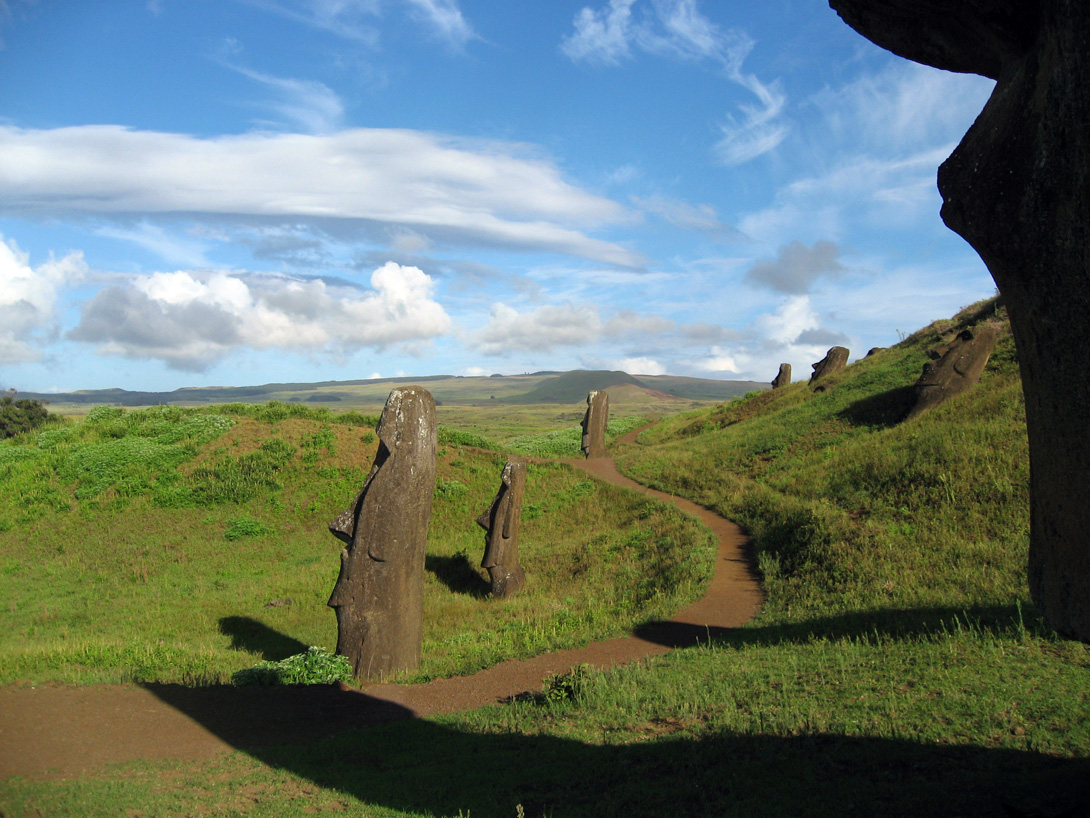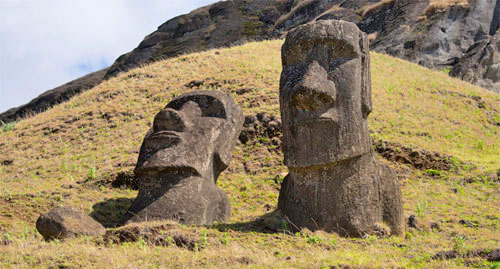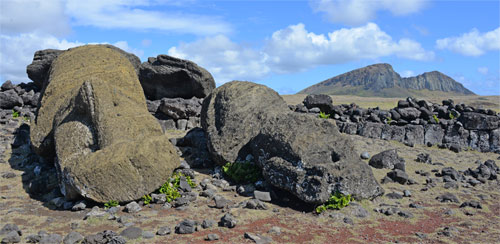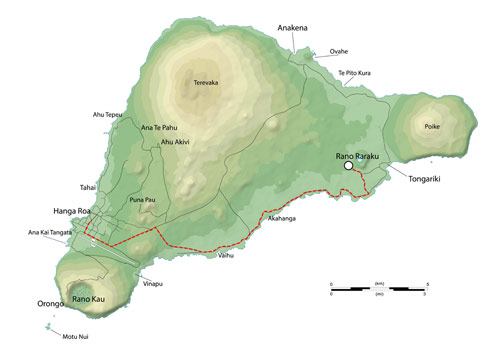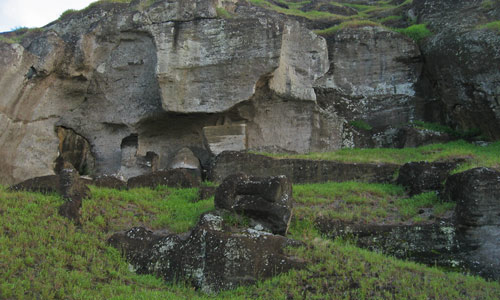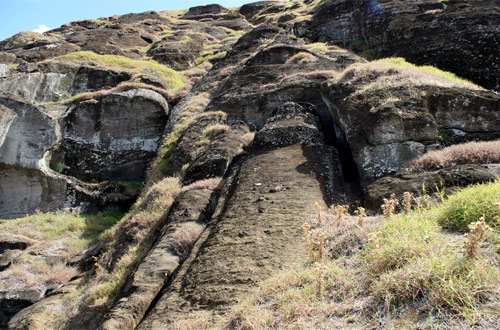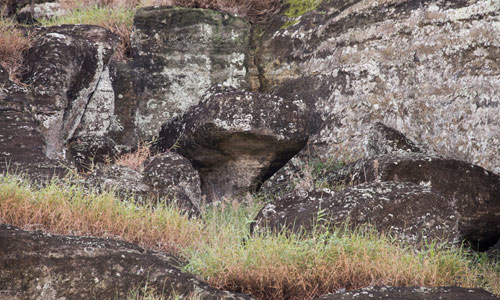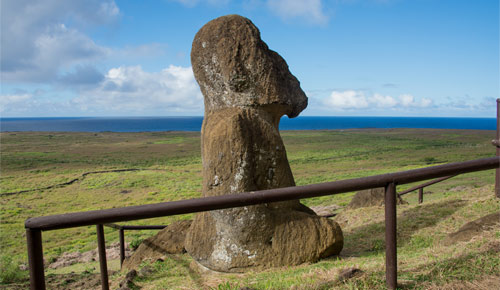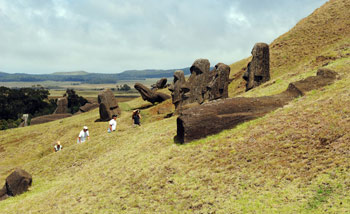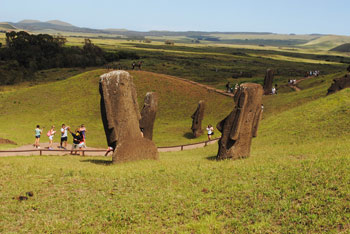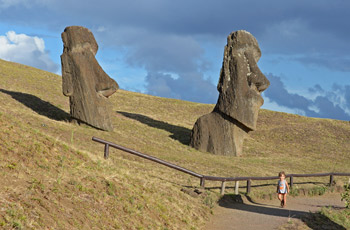
Rano Raraku, moai statue quarry
Warning: Undefined variable $str in /home/easter40/_domains/easterisland.travel/includes/functions/showBar.php on line 13
- Rating





- Most crowds11:30 - 13:00
- Best photographyAll day, summer
Walk among giants in the legendary moai statue quarry Rano Raraku. This volcano that was turned into a factory invokes a sense of mystery in an almost surreal way, stronger than any other place at Easter Island. This is the heart of ancient Rapa Nui civilization with hundreds of abandoned moais scattered around. Almost all moai statues were carved here, before being transported to all other corners of the island. Here we see many demonstrations of the incredible skills in statue carving that was reached in the ancient Easter Island society, since we here have the largest and most refined statues of the whole island.
There are approximately 400 statues left at Rano Raraku. Of these, around half are finished and the rest never reached a completed state.
According to Katherine Routledge, one of the first European explorers that investigated Easter Island in her 1914 visit, the statue builders that inhabitated Rano Raraku were like mercenaries. They had left their tribes to become statue builders. This was their profession, and statue building was actually nothing but a business; moais were sold to other tribes for food, tools, ropes or whatever the buyers had available. The price of a statue depended on its size.
The tradition of building statues lasted four centuries. The moais were small at first, but as skills were constantly refined, the statues grew in size over the generations. In the end, monstrous megaliths of up to 10 meters tall and 80 tons heavy were successfully carved and transported kilometers over hilly terrain. This took a big toll at the forest population. Due to the island's small size and fragile ecosystem, total deforestation was the result, from being a jungle with millions of palm trees when people had first arrived less than thousand years earlier. Since big amounts of lumber was needed only to transport the statues and not for carving them, the production could go on for a while, but the moais could not be taken out of the quarry. This is may be why there are so many large, refined statues in perfect condition, ready to be delivered, but simply were left behind instead.
Buried moai statues of Rano Raraku
Many statues at Rano Raraku are buried halfway or more into the ground. This is where the misconception of calling the moai statues Easter Island heads comes from. Truth is that they all have bodies, even though sometimes only a head is sticking out of the ground.
The reason the moai statues are buried into the ground is because of the way the ancient quarry workers handled the incredibly heavy weight of the statues. Once they were detached from the rock in the upper portions of the volcano, the statues were slid down to the hilly, lower areas of Rano Raraku where there is soil. Here, a great pit had been dug. Once a statue reached its pit, gravity tilted it until it was fully erected. Using this clever technique, the quarry workers saved themselves the great labour of raising every statue by hand.
When a moai was ready to be taken away from Rano Raraku, the soil in front of the statue was removed to create a path. This was possible as the buried statues were always at high ground.
Why did Rano Raraku become a factory?
Rano Raraku was chosen as a factory not for its location, but for the rock it consists of. The material is called tuff (or sometimes tufa, which is simply volcanic ash. This particular volcano spewed out huge amounts of ash during its eruption, and when this ash landed on the ground, it melted together, forming the tuff material. Prevailing southward winds during the eruption was what gave the volcano its peculiar shape of a long slope.
The volcanic rock of Rano Raraku, tuff, was found to be the far superior material when making statues. In the ancient Rapa Nui society there was no metal, and the tools used were nothing but simple rocks, it was essential for the material to be soft, to be carved more easily. As tuff is essentially volcanic ash, it is softer than any other rock at Easter Island.
Statue decay of Rano Raraku statues
Since tuff is soft, it is also fragile. With only wind, rain and temperature changes, the rock withers quite quickly. This means that the Rano Raraku moai statues are slowly disappearing. We see the effects now of the tooth of time over the last centuries, but the ancient statue carvers didn't worry about this, and probably didn't even know that the tuff would have this characteristic over time.
The tuff being so fragile is why it is forbidden to touch the statues. As Easter Island has an ever growing tourism, if everyone would touch the statues there wouldn't be much left after 100 years. This cocept is called cumulative impact. It is important that this is respected, even if no park ranger, local or tourist is around. Touching the statues or other Easter Island archaeology may result in a fine or prison.
Visiting Rano Raraku
To visit Rano Raraku with a local guide, you may do so in our tours Megaliths and Express among others.
Get to Rano Raraku
Rano Raraku is located in the east side of Easter Island. Leave Hanga Roa on the main island road called Hotu Matu'a that leads to Anakena. After the airport the road will curve to the left. After 2 km you'll see a sign indicating that Rano Raraku is to the right. Turn here. This road will take you along the south coast of the island. Continue this road eastward, and after 20 minutes you will have arrived to the east side of Easter Island. Rano Raraku will appear on your left side. You can recognize it from its characteristic sloping shape, spotted with statues along the hills around the volcano. A road will soon appear on your left side to let you access the quarry.
Two paths
Rano Raraku and the birdman village Orongo are the only sites that have paths. The idea is to stay on this path, and there are park rangers patrolling the area to make sure we do.
The path starts after the reception where park tickets are checked. Just after entering, you'll have an ancient chicken house, or hare moa, to your left. A few more steps the path splits in two. To the right you'll have the main attraction of visiting the main quarry sites and you'll be walking among countless of moais. The path loops, and at the end you'll visit the kneeling moai with a view of Ahu Tongariki.
The left path will take you to the crater lake in the interiors of the volcano. Once standing by the lake, you'll be able to spot moai statues to the right from a distance, along the sides of the volcano. The Rapa Nui triatlon called tau'a performed here during the Tapati Rapa Nui festival is one of the festival's highlights, and always attracts lots of spectators.
Great quarry
In the upper portions of the path you'll find the quarry that has been used more than any other area of Rano Raraku. As a result, there is a huge empty space in the rock wall. Many holes and flat walls can be seen all over this area, showing that man has worked this area. Two unfinished statues still attached to the mountain can be spotted.
In the middle of the quarry, the head of a statue is resting on the rock. This moai was dropped in the delicate and difficult process of lowering it down from the mountain. The fall must have been hard, as the body is several meters away, below the path.
The Giant
Just after the big quarry in the volcano lays the largest statue ever built - The Giant. This monster made by an optimistic group of carvers has a height of 21.75 meters (71 feet) and an estimated weight of 200 tons. It was never finished. When it was abandoned, the carvers were working on making trenches along the sides to detach it from the volcano. It is unclear whether this statue was abandoned because the statue carving era ended, or because the workers simply thought it would be too hard to transport.
American William Thompson, first archaeologist to ever visit Easter Island, recorded an account in 1886 of this statue being meant for the most perfectly made rock wall Ahu Tahira.
Outlined statue
To the right of The Giant, just a few meters from the path, there is a piece of tuff that demonstrates the first stage of the statue construction process. On this rock, a statue has been outlined. The moai statue carvers didn't get very far until they found out that the material wasn't good enough in the bottom of this statue, so the project was cancelled. The bad tuff was removed from the rock wall, and a path was built leading to the upper regions of Rano Raraku where better material was found.
Moai with keel
In the last stage before detaching a statue from the volcano, a keel of stone along the back of the statue was removed. Only one statue is visible from the path that has this thin strip of stone. This statue can be spotted from the same hill where The Giant is laying. Look for the ancient path leading upwards, starting from the outlined moai. This path later turns into a big open space. In the middle of this open area you can spot the top of the head and the nose of this statue.
Moai with rock inclusions
The problem with making statues of tuff is that it is not homogenic; it has cracks and rock inclusions. This statue is an example of that. Two big hard rocks are on and below the face. A statue like this could not be sold, so it had to be abandoned.
Moai Tukuturi, kneeling moai
Where the path goes around the corner of the volcano you'll have a panoramic view of Poike and Ahu Tongariki. Reaching the end of the path, it will loop, and here you'll find the only moai with legs, known as Moai Tukuturi or Moai Tūturi, meaning "kneeling moai".
A lesser known Easter Island legend tells the story of how this one came to be. At the top of volcano Rano Raraku, there are big man-made holes called pū makari, meaning "zip-line holes". According to oral tradition, tree trunks were placed in these holes, and a rope was pulled all the way to Ahu Tongariki. Whenever they had some free time, the statue builders used this rope to do zip-lining, or canopy. One person called Vai Ko Veka fell when he did this, and he died. When he was dead, laying on the ground, his legs were folded together, so it looked like he was kneeling. When his friends then made a statue for him, they made a kneeling statue. The true name for this statue would then be Moai Vai Ko Veka.
The kneeling moai was excavated by norwegian explorer Thor Heyerdahl in 1956.
Statues from other places
95% of all Easter Island statues were made here, which means that there are around 50 statues made out of a different material, quarried from a different place. A whole 20% of these can be found in one single place at the back of Poike and are made out of trachyte - a grayish rock. Others are made out of hard basalt rock or red scoria, and are scattered all over the island.
There are two reasons why statues sometimes were made at a different location than at Rano Raraku:
- The statues are from a time when volcanic tuff of Rano Raraku still hadn't been discovered as the superior material for making moais.
- Volcano Rano Raraku was simply too far away, and the tribe that wanted to obtain statues would have to transport the statues through too tough terrain or too much elevation.
Photography at Rano Raraku
As Rano Raraku has statues facing all directions, there is no one best moment during the day for taking photos here. It all depends on the statues you want to take photos of.
Summer is better for taking good photos in Rano Raraku. In winter, many statues are completely covered in the volcano's shade due to the low position of the sun.
